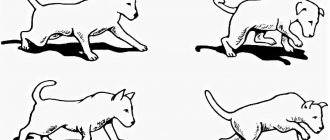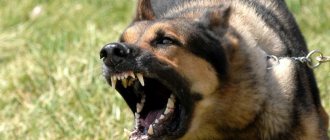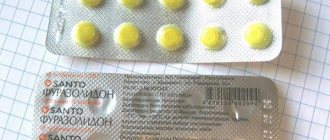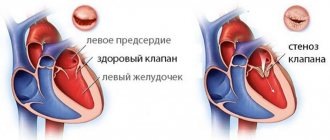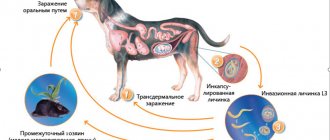Vitamin deficiency in dogs is a disease that develops due to improper nutrition in which there are no vitamins necessary for the animal. A constant deficiency of nutrients leads to lethargy, the development of other diseases and disorders of the internal organs. Often dog owners do not pay special attention to this condition, not even realizing that long-term lack of treatment can lead to the death of the animal.
What is vitamin deficiency in dogs
Problems of supplying dogs with vitamins are quite common, but vitamin deficiency is characterized by a complete absence of any useful substances in the diet. Even experienced veterinarians sometimes confuse the disease with hypovitaminosis or polyavitaminosis. It is worth defining the terms:
- Vitamin deficiency - the disease develops due to a complete lack of vitamins in the dog’s diet;
- Polyvitaminosis is a disease in which an animal lacks several types of vitamins, but enough others;
- Hypovitaminosis is a disease that means a vitamin deficiency in a dog’s diet.
Vitamin deficiency in dogs is considered the most dangerous type of possible vitamin problems.
What is
People often do not attach importance to this problem. However, in severe forms, vitamin starvation can lead to the death of a dog. Vitamin deficiency occurs in animals with a severe lack of one or an entire group of vitamins.
Healthy and cheerful dog
The mildest form of the disease is hypovitaminosis. With it, there is not a complete absence, but only a lack of useful organic compounds. Hypovitaminosis usually occurs in the spring, because fatigue is acutely felt after winter.
It is extremely important to quickly recognize emerging problems. Vitamins are organic substances that strengthen the immune system, they keep viruses out and fight infections. If the animal does not have them, then the body’s systems will stop working normally. The dog will be defenseless against infections and various diseases.
Causes of disease development in dogs
In most cases, this condition develops against the background of other diseases or conditions. Veterinarians identify a number of the most common causes of vitamin deficiency in pets:
- Gastrointestinal diseases;
- Worm infestation;
- Infectious diseases requiring high immunity;
- Pregnancy and after childbirth;
- The period of estrus and sexual hunting;
- After treating a dog's illness with antibiotics.
Four-legged animals often suffer from leptospirosis, chlamydia, parvovirus enteritis, mycoplasmosis and canine distemper - such diseases provoke an increased consumption of vitamins by the pet’s body. As a result, the amount of nutrients obtained from food is not enough to cover the body’s needs, and vitamin deficiency develops.
Read Method of use and cost of Advantage for dogs
Effective treatment
Signs alone are not enough to determine a deficiency of specific vitamins; confirmatory tests are necessary. Therefore, it is better to go to the veterinarian for treatment.
The doctor will examine the dog’s condition and prescribe a separate drug in the form of tablets, injections, or select a multivitamin complex.
In case of a complex type of vitamin deficiency, it is necessary to simultaneously treat the underlying disease. Without this, it is not possible to correct the pet’s condition.
How to help at home
When thinking about how to treat vitamin deficiency at home, first of all, the dog owner should review the animal’s menu. Some products help replenish the substances the body lacks.
What to include in the diet for vitamin deficiency
| Vitamin | What products contain |
| Group B | Meat, offal, eggs, cabbage, spinach, meat and bone and fish meal |
| A | Dairy products, egg yolks, butter, spinach, carrots, fish oil |
| C | Potatoes, spinach, cabbage, lettuce |
| D | Fish oil, meat and bone meal, eggshells |
| E | Vegetable oils, wheat germ |
| K | Greens, fishmeal |
A whole complex of vitamins a dog needs is located in the liver. It is better to choose beef and give it raw.
The daily diet should contain porridge. Buckwheat, oatmeal, and millet are considered the best for pets. Brewer's yeast would also be a good addition to the menu.
Symptoms of vitamin deficiency in dogs
The first sign indicating vitamin deficiency is the dog's strange behavior. Pets with problems begin to eat soil, grass, and feces. Other signs include lethargy, apathy, unhealthy appearance, and coat problems. Other symptoms can help determine which specific vitamin is missing.
A deficiency
At the initial stage, the symptoms are invisible, then the dog becomes lethargic, immobile and irritable. In puppies, weight gain and growth are greatly reduced. A distinctive sign is the pet’s severe thirst and refusal to eat. In advanced stages, a dog suffering from vitamin A deficiency develops problems with vision, gastrointestinal tract, and respiratory system.
If retinol deficiency is suspected, veterinarians look into the dog’s oral cavity; if the mucous membranes are dark and dry, this is almost 100% a problem with vitamin A.
B2 deficiency
Refusal to eat becomes critical; the dog even stops eating his favorite treats. Lethargy, low activity, refusal to follow commands. In a month of riboflavin deficiency, a dog can lose up to 5 kilograms in weight. In the future, vision problems and uniform hair loss are also possible.
Prolonged absence of treatment can lead to paresis of the hind limbs. In essence, the animal becomes disabled. All this is accompanied by disturbances in the functioning of the heart and nervous system; inflammation of the mucous membranes and outer layers of the skin is possible.
B5 deficiency
The vitamin is responsible for the metabolism of proteins, fats and carbohydrates that are vital for dogs. With a deficiency of pantothenic acid, indigestion, loss of appetite, apathy and drowsiness are observed. Characterized by increased salivation and a coating of the tongue with a dark coating. There is a high probability of inflammation of the epidermis; puppies in this condition stop growing.
B6 deficiency
The lack of this substance in the body is already quite dangerous. Due to disturbances in the functioning of the nervous system, the dog may suddenly experience seizures. The spectacle is not for the faint of heart: it all starts with increased anxiety and tremors in the limbs, and at the peak the dog may even lose consciousness from pain. After a seizure, the dog looks stunned, most likely it will have a headache, and is poorly oriented in space.
B6 deficiency should not be allowed in a dog - this can lead to anemia or leukopenia. Such diseases lead to death in 40% of cases.
B12 deficiency
B12 deficiency is characterized by severe weight loss in the dog due to lack of appetite. The decrease in body weight is noticeable even without weights; the pet’s ribs are visible. The functioning of the digestive system is disrupted, both diarrhea and constipation are possible. In advanced cases, anemia may develop. In some representatives, the symptom was the appearance of a rash and itching of the skin.
Read Adenoma of the eye (third eyelid) in dogs: causes, treatment and prevention
Disadvantage C
This vitamin is very important for the functioning of the internal organs of a dog, as well as a person. Ascorbic acid deficiency is characterized by weakness, drowsiness, and inactivity. The mucous membranes become reddened. Often a sure sign of the disease is bleeding gums.
Blood fractions may also appear in the pet’s feces and urine.
D deficiency
The occurrence of such vitamin deficiency is associated with a lack of calcium and phosphorus in puppies and young dogs under two years of age. Deficiency is characterized by symptoms unusual for the disease:
- Increased and perverted appetite;
- Disorders of the digestive system;
- Convulsions are possible;
- Lameness develops;
- Changing the size of joints;
- Deformation of bone structure;
In addition, a lack of calciferol leads to vomiting, disruption of gait and nervous system function.
Vitamin E
There are no obvious symptoms of this type of vitamin deficiency. The disease can only be suspected in an advanced stage, then the dog’s hind limbs fail and complete paralysis is possible. The function of the reproductive system is impaired. In male dogs, a lack of vitamin E often leads to infertility and impotence.
Vitamin K
The main symptom is considered to be an increased predisposition of the dog’s body to hemorrhages (hemorrhagic diathesis). Any injury can lead to loss of large amounts of blood and serious consequences. In dogs, wounds do not heal well and often begin to fester.
Symptoms of canine vitamin deficiency
Many owners consider a perversion of appetite to be a reliable sign of vitamin deficiency: the dog begins to eat soil, feces, and inedible objects. However, this symptom may indicate many other diseases of the gastrointestinal tract or nervous system.
Changes in the coat are also associated with vitamin deficiencies, however, this sign is unreliable: the quality of the coat depends on too many factors of the pet’s health. Therefore, often giving a dog vitamins “for fur” is at best ineffective, and at worst leads to a worsening of the situation.
Seizures among owners are considered a reliable sign of a lack of B vitamins. This is only true if the dog has been poisoned with isoniazid; in other cases, this indicates serious, often life-threatening conditions, especially in whelping or recently whelped bitches.
Thus, any ill health of your pet can indicate vitamin deficiency. And since the symptoms of vitamin deficiencies are very similar to the symptoms of a variety of diseases, only a veterinarian can make an accurate diagnosis. It is better not to use vitamin preparations on your own: in most cases, the symptoms of deficiency and excess of vitamins are very similar, and this can confuse the doctor.
Treatment of vitamin deficiency in dogs
Therapy consists of taking a specific vitamin or vitamin complexes. The choice of drug should be handled by a veterinarian, and self-medication can lead to unforeseen consequences. Typically, specialists prescribe drugs in the form of tablets, powders or injections:
- 8IN1 EXCEL MULTI VITAMIN SENIOR;
- POLIDEX MULTIVITUM PLUS;
- Beaphar;
- Trivit;
- Pyridoxine;
- Mukovit;
- Cyanocobalamin;
In the initial stages, the doctor may refuse to prescribe medications and will limit himself to recommendations for changing the dog’s diet. The best natural sources of vitamins are eggs, meat, fish, and vegetables.
Treatment
How to treat vitamin deficiency in dogs? In fact, the specificity of therapy is the same - to compensate for the deficiency of microelements.
- Vitamin A. For treatment, foods and supplements enriched with this substance are introduced into the diet.
- Vitamin B12 deficiency is treated by subcutaneous injection of a special solution.
- Vitamin C. Veterinarians advise introducing cabbage and special vitamin complexes into the diet. It should be noted that heat treatment of food significantly reduces the content of this substance in it.
- Vitamin D. For treatment, an oil solution containing this trace element is prescribed.
- You can increase the amount of vitamin E by introducing various types of cereals into your diet, including oatmeal and buckwheat.
- AT 2. If, after introducing fish and meat products, as well as eggs, the animal’s condition does not improve, vitamin B2 in its pure form is prescribed.
- B6 is contained in high-quality food; in addition, preparations that include pyridoxine are used.
In any case, if signs of vitamin deficiency occur in dogs on the skin, coat, etc. you should contact your veterinarian.
Consequences of lack of treatment
The disease will progress and gain momentum. Life expectancy forecast is up to two years, depending on the type of deficiency. Veterinarians highlight the most dangerous consequences:
- Changes in bone structure and skeletal structure;
- Paresis of the hind limbs, disability;
- Liver failure;
- External and internal hemorrhages;
- Anemia;
- Disorders of the nervous system;
- Blindness.
Read How to treat diarrhea in a dog at home
Depending on the type and stage of vitamin deficiency, death can occur either after a month or after 2 years. One thing is certain: if left untreated, the dog will end its life prematurely due to vitamin deficiency.
- About vitamins, hypovitaminosis and avitaminosis
- Vitamin A
- B vitamins
- Vitamin C
- Vitamin D
- Vitamin E
- Vitamin K
- Vitamins against diseases
Chapter 14. Basic vitamins and painful conditions in dogs associated with their deficiency or excess
About vitamins, hypovitaminosis and avitaminosis
Vitamins (from Latin “vita” - life)
— these various organic compounds are named so for a reason: their role in the life of the body, both animals and humans, cannot be overestimated.
Vitamins increase the intensity of all physiological processes, help protect against adverse environmental influences, increase resistance to infectious diseases, and during periods of illness contribute to a speedy recovery.
The absence or deficiency of vitamins in the body leads to disruption of a number of its most important functions.
Vitamins were discovered by our compatriot N.I. Lunin in 1880. It was he who proved, by conducting experiments on laboratory white mice, that the absence of vitamins and substances necessary for animal life in food leads to their rapid death.
Compared to the main nutrients - proteins, fats, carbohydrates and mineral salts - the body requires vitamins in very small quantities: only a few hundredths of a milligram per day. But even in these small quantities, vitamins have a beneficial effect on metabolism, stimulate growth, development, reproduction, have a positive effect on the general condition, increase resistance to various diseases, both infectious and non-infectious, strengthen the muscular, bone, circulatory and other systems of the body, and act they are all interconnected.
Currently, over 30 vitamins are known. They are designated by capital letters of the Latin alphabet: A, B, C, etc. Vitamins A, B, C, D, E are especially important for animals. Their deficiency is observed most often and leads to vitamin deficiency and hypovitaminosis.
Hypovitaminosis
occurs when the dog daily receives less vitamins than the body’s daily requirement.
If an animal does not receive the required amount of vitamins for a long time, then vitamin deficiency occurs.
But avitaminosis and hypovitaminosis in dogs can develop even if there is a sufficient content of vitamins in the food. The cause of the development of these diseases may be the body's increased need for vitamins, which occurs in... as a result of various factors, such as low or high air temperature, as well as during pregnancy and feeding puppies.
Vitamin deficiency, in addition, can develop as a result of disruption of the gastrointestinal tract in the presence of helminths in the intestines, especially tapeworms, during or after various infectious diseases, in the treatment of which antibiotics and sulfonamide drugs were used, which promote the breakdown of vitamins.
Vitamin A
Vitamin A (or carotene)
necessary for dogs' bodies all the time. Entering the digestive tract with food and then into the blood, carotene exhibits vitamin A activity, since when it breaks down, it produces vitamin A.
Vitamin A was discovered this way. Mice and dogs fed low-fat ether food became sick. Their eyes became inflamed, they lost weight, grew poorly and, as a rule, died. Since the signs of this disease developed only when feeding low-fat food, scientists came to the conclusion that when the food was low-fat, some substance necessary for life was removed from it. This substance was called vitamin A. At the same time, scientists noticed that feeding animals with obvious signs of vitamin A deficiency with carrots, tomatoes, and beets contributed to their cure. The reddish-yellow pigment, carotene, was named provitamin A.
Vitamin A is found in some animal organs and animal products. The liver of sea fish is richest in vitamin A, and among meat products - beef and pork liver.
The main foods containing vitamin A are milk and butter. However, the content of vitamin A in dairy products varies at different times of the year.
There is a lot of vitamin A in the yolks, but the percentage of content also depends on the time of year.
The source of carotene is green plants - clover, alfalfa, meadow and forest grasses - and root vegetables: carrots, beets, pumpkins, etc. Fruits and berries are less rich in carotene.
A dog needs vitamin A for normal vision (it is part of the visual purple of the retina), for growth (for a puppy), to maintain the normal condition of the skin, coat and mucous membranes.
The disease that occurs due to acute deficiency of vitamin A is called A-vitaminosis. In this case, the puppies are observed to be stunted in growth and lose weight. Lesions of the skin, mucous membranes of the eyes, lungs, bronchi, trachea, gonads and other organs develop. A specific sign of vitamin deficiency is eye disease. In this case, a change occurs in the mucous membrane of the eyes, expressed in dysfunction of the lacrimal glands and in a delay in the secretion of secretions. Changes in the mucous membrane cause damage to the cornea of the eye. This disease is called xerophthalmia, or dry eye. Then a disease called “night blindness” develops, i.e. loss of the ability to see at dusk.
With A-vitaminosis, the body's resistance to infections is weakened. Microbes and viruses, penetrating through the affected areas of the skin, enter various tissues and organs. Changes occur in the nervous system and in the epithelium of the gonads and organs, which often leads to loss of reproductive ability.
Excess vitamin A also has a harmful effect on the dog's body. Experiments have shown that administering large doses of vitamin A to dogs of various breeds has a toxic effect: dogs lose weight, dry corneas appear, and changes in individual organs and tissues occur.
Therefore, due to the excess vitamin A in bear liver, it is not recommended to use it for feeding dogs.
B vitamins
This group of vitamins is the most numerous. It contains more than 20 different substances. Some of them have been studied fully, others to a lesser extent. The following B vitamins are most important for dog breeding: B-1 (thiamine), B-2 (riboflavin), B-6 (pyridoxine), B3, or PP (nicotinic acid), B-5 (pantothenic acid), vitamin B-12 (cyanocobalamin), Sun (folic acid).
Vitamin B-1 (thiamine)
is an antineurological vitamin. Its deficiency leads to metabolic disorders with damage to the nervous and muscular systems, endocrine glands and digestive tract. Particularly noticeable changes occur in the nervous system. They are expressed by polyneuritis, convulsions, paralysis. A lack of vitamin B-1 contributes to weakness of labor, prolongation of labor, and postpartum complications.
Vitamin B-1 is found in significant quantities in foods of plant origin: cereals, root vegetables, fruits, beans, nuts. This vitamin is found in soil, standing water, yeast, and microbes. Among the internal organs of animals that are usually fed to dogs, the liver, kidneys, and heart are rich in vitamin B-1.
Dog owners need to remember that with muscle load, lactation (the process of formation and secretion of milk by the mammary gland), pregnancy, illness, and with an increase in carbohydrates in the diet, the animal’s need for vitamin B increases, and with an increase in fat in the feed, it sharply decreases.
Vitamin B-2 (riboflavin)
found in both plant and animal tissues. Baker's and brewer's dry yeast, as well as liver, kidneys, and heart are rich in it.
The source of vitamin B-2 for dogs raised at home is meat and dairy products, which constitute their main diet.
Specific signs of B-2 - vitamin deficiency are: thinness, hair loss on the back, especially in the sacral area, around the eyes, ears and chest, dermatitis, cracks in the mucous membranes, clouding of the cornea of the eyes, development of kerato-conjunctivitis, muscle weakness, partial paresis limbs, decreased body temperature, pulse, breathing. In puppies, the first sign of vitamin B-2 deficiency is growth retardation. If measures are not taken in a timely manner, the death of the animal occurs.
The enormous importance of vitamin B-2 in metabolism is based on its participation in the synthesis of the most important enzymes of biological oxidation. It should be noted that for therapeutic purposes, vitamin B-2 can be successfully used for inflammation of the mucous membranes, cracked nipples in nursing dogs, and long-term non-healing wounds.
Vitamin
B-6
(pyridoxine)
is found in many foods of animal and plant origin (yeast, cereals, beef liver, fish, eggs, etc.).
Vitamin B-6 ensures normal absorption of proteins and fats and plays an important role in nitrogen metabolism.
Vitamin deficiency occurs during pregnancy and certain nervous and skin diseases.
The lack of vitamin B-6 leads to damage to the nervous system with the development of seizures similar to epilepsy, growth retardation, anemia, and skin inflammation.
Vitamin B-3, or PP (nicotinic acid),
used to prevent pellagra (translated from Italian as “rough skin”), accompanied by damage to the nervous system and digestive organs.
Recently, it has been found that vitamin PP can be synthesized in the body of dogs.
For therapeutic purposes, vitamin PP can be prescribed to dogs with increased dryness of the skin, enteritis (inflammation of the small intestines), colitis and some nervous diseases - complications after the plague.
Sun, or folic acid
(from Latin
folium
- leaf), was first isolated from spinach leaves, found in yeast, green plant leaves, liver and buds, both in a free state and in the form of complex compounds.
With a lack of folic acid, anemia and leukopenia develop. Puppies experience growth retardation, emaciation, dry skin, and dandruff.
Folic acid helps regulate hematopoietic processes and stimulates the functions of the gonads.
Vitamin B-12 (cyanocobalamin)
found in milk, eggs and other foods; Beef liver and kidneys are richest in it. Can be synthesized by microbes. Vitamin B-12 synthesized by microorganisms is found in soil and in the sludge of standing water bodies. Vitamin B-12 is not found in plant foods.
The lack of this vitamin in the body of dogs is a fairly common phenomenon and consists of the following: many immature blood cells appear in the bone marrow, since the formation of red blood cells is delayed; At the same time, a large number of red blood cells disintegrate; the hemoglobin content in the blood decreases sharply. Tissue oxidation is disrupted. Dogs develop nervous disorders. In mild cases of vitamin deficiency, lethargy of the animal, pallor of the mucous membranes, increased thirst, and impaired defecation and urination are observed. Colic occurs, the liver and spleen enlarge. Intramuscular or intravenous administration of vitamin B-12 has a magical healing effect.
Vitamin B-12 is used for liver dysfunction, hematopoietic disorders, and nervous system disorders.
Vitamin
B-5
(pantothenic acid)
is found in various plants and animal tissues (in brewer's and baker's yeast, liver, egg yolk, rice, carrots, cabbage, potatoes and many other foods used to feed dogs).
Pantothenic acid is necessary for proper metabolism in animals.
With a deficiency or absence of it, dogs develop dermatitis, depigmentation of hair and hair loss, which owners often mistake for shedding. Keratitis is often associated with these diseases, and damage to the nervous system, adrenal glands and other organs is observed. Currently, there are suggestions that the early appearance of gray hair in dark-colored dogs is associated with a deficiency of pantothenic acid in the body.
Vitamin C
Vitamin C (ascorbic acid)
plays an important role in metabolism. Ascorbic acid activates the action of all enzymes in the animal's body.
Vitamin C is widely distributed in nature. There is especially a lot of it in raw vegetables, fruits, and berries. The liver, pituitary gland, adrenal glands, and eye lenses are very rich in it. There is slightly less ascorbic acid in muscle tissue. Cow's milk contains trace amounts of vitamin C; There is more of it in mare's milk - kumiss.
Ascorbic acid plays an important role in the treatment of various infectious diseases of dogs; it is not for nothing that vitamin C is called anti-infectious. It slows down the growth of some pathogenic bacteria and even causes their death, thereby increasing the resistance of both puppies and adult dogs to infection. Ascorbic acid has also been used as a medicinal substance for scurvy, anemia (anemia), various poisonings and gastrointestinal diseases.
Vitamin D
Vitamin D (calciferol)
was discovered in the 17th century in connection with the study of diseases such as rickets.
This disease is also common in dogs. Puppies are primarily susceptible to rickets.
Scientists have been looking for a cure for rickets for a long time. Finally it was found - it turned out to be fish oil. In 1919, it was proven that irradiation of meat, bran, and beef fat with a quartz lamp leads to the appearance in these food products of a factor that is also capable of preventing and curing rickets. This factor was called vitamin D.
However, it took a lot of time and effort until it was possible to isolate a pure vitamin with high antirachitic activity. It turned out to be vitamin D2 (ergocalciferol).
The liver of fish, marine animals and cattle is richest in this vitamin. Plants contain provitamin D, which turns into vitamin D when exposed to ultraviolet rays.
Vitamin D helps retain phosphorus and calcium in the dog’s body and deposit them in bone tissue.
In the absence or insufficient amount of vitamin D in food, puppies develop rickets. Their bones become flexible, soft, bend and deform under the weight of the body, teeth grow poorly, and digestion is impaired. Rickets is a disease associated with metabolic disorders in general, but disturbances in the metabolism of mineral salts, and primarily calcium and phosphorus, are especially pronounced.
Rickets in puppies develops when there is a predominance of calcium in the diet and a lack of phosphorus. The more calcium with a normal phosphorus content, the sooner rickets develops. A calcium to phosphorus ratio of 2:1 or 1:1 is the most favorable, and at a ratio of 3:1 rickets already occurs. This once again suggests that the dog owner must monitor the correct ratio of mineral salts in the animal’s food.
Vitamin E
Vitamin E (tocopherol)
translated from Greek means “promoting childbirth.” Vitamin E is found mainly in plants and in very small quantities in animal tissues, mainly the liver. The main “supplier” of vitamin E is vegetable fats.
Scientists have concluded that long-term feeding of adult dogs with milk alone causes a loss of the ability to reproduce offspring. It was found that the cause of infertility is the lack or absence of a special substance in food, which was called tocopherol - vitamin E.
Vitamin E is especially necessary for dogs during fetal development. It also ensures normal childbirth. It is a radical treatment for postpartum complications.
With E-vitaminosis, not only infertility is observed, muscle activity deteriorates, the central nervous system is affected, and paresis and paralysis of the limbs can develop.
Vitamin K
This vitamin gets its name from the word “coagulation,” which means “clotting” (of blood). It was discovered in experiments on chickens. If in normal birds the bleeding stopped after 1-10 minutes, then in sick birds the blood flowed for a long time. It turned out that the reason for this is the lack of a special substance in the feed, which was called vitamin K;
its deficiency leads to a sharp decrease in blood clotting ability.
In dogs, in the absence of vitamin K, hemorrhagic diathesis develops: hemorrhage under the skin, into the peritoneal cavity, into the muscles. Due to a decrease in prothrombin content, the blood clotting process is delayed, and any, even minor, injury causes heavy blood loss.
Vitamin K is found in green parts of plants, fish meal and other animal products.
Vitamins against diseases
There is no area in practical veterinary medicine where vitamins are not used. But vitamins are not the only means for treating a particular disease; they are only an integral part of a complex of medical procedures prescribed to sick animals.
Vitamins largely determine the overall reactivity and resistance of the body and form the response to infection. The initial period and course of the disease depend on the degree of saturation of the dog’s body with individual vitamins, which undoubtedly affects its outcome. Infectious diseases in a dog with vitamin deficiency occur in conditions of reduced body resistance, i.e., more severely.
Vitamin C plays an important role in the treatment of dogs. There is a certain connection between the degree of saturation of the animal’s body with vitamin C and the response to the causative agent of an infectious disease. An insufficient amount of this vitamin leads to a decrease in the body's defense reaction and a decrease in both the natural and acquired immunity of the animal to infectious diseases, including plague and hepatitis.
Vitamin C, as already mentioned, is called the anti-infective vitamin. It can neutralize toxic waste products of various microorganisms, has a positive effect on the body of a sick dog, increases immunity, stimulating the production of antibodies and the phagocytosis reaction. Therefore, the need for vitamin C in a sick animal increases sharply.
Vitamins that affect the infectious process include vitamin A. By regulating the functioning of the epithelium of the skin and mucous membranes, it prevents the penetration of infectious agents into the dog’s body.
Vitamins B-1, B-2, B-6, and PP are also of considerable importance in the treatment of infectious diseases, which enhance the antibacterial effect of sulfonamide drugs and antibiotics.
For non-contagious skin diseases in dogs resulting from a lack of vitamins, vitamins B-6, A, B-3 should be used.
Pantothenic acid enhances the activity of the sebaceous glands and stimulates hair growth. Vitamins A, C, B-12, B-2 help rid animals of dandruff.
It has been noted that vitamins A, C, E and others also influence the metabolism of sulfur in the skin, which is involved in biological processes that determine hair growth.
Vitamins are active assistants in the treatment of eczema, neurodermatitis and various pustular diseases.
Vitamins A, B-1, B-2, C are widely used in the treatment of eye diseases.
Much attention should be paid to the use of vitamins in the treatment of various injuries.
Domestic researchers have proven that injuries, wounds, and surgery increase the animal’s body’s need for vitamins, especially vitamin C.
When treating wound surfaces in dogs, an oil solution of vitamin A is successfully used topically, which has an analgesic effect, stimulates the growth of epithelial tissue and creates a protective film over the wound surface.
Vitamin K is used to stop bleeding and stimulate wound healing. Irrigation of fresh shallow wounds with a 1% solution of vitamin K is effective, which heal quickly, forming a durable scar.
Currently, data have been obtained on the positive effect of vitamin B-12 on the treatment of injuries accompanied by bone fractures. Vitamin B-12 helps restore the functional state of injured nerves, bone tissue and the healing of wound surfaces of the skin and muscles, accelerates the formation of new blood vessels and young muscle cells after injury to the dog’s skeletal muscles.
Vitamins A and D also have a positive effect on the process of callus formation in the event of a bone fracture.
It has been proven that in dogs with vitamin C deficiency, fractures did not heal, and healing ended with the formation of a false joint. With D-vitaminosis, the formation of bone callus was slow; with B-beri, polyneuritis was added to this.
However, vitamins are by no means harmless: if in excess in the body, they, like all biologically active substances, can have harmful effects. Poisoning of dogs with large amounts of vitamins is called hypervitaminosis.
Hypervitaminosis
can be
acute
(one-time intake of very large doses of the vitamin into the body) and
chronic
(long-term intake of the vitamin in doses exceeding the body's needs).
For example, in an effort to prevent rickets in puppies, owners generously treat them with vitamin D, as a result of which irreversible processes occur in their tissues and organs, the calcium content in the blood increases, which leads to the deposition of mineral salts in the tissues of the heart, lungs, kidneys, etc. wall of the stomach. The nervous system also suffers. The puppies become lethargic, lie around a lot, don’t play, and eat poorly. Vomiting and diarrhea are often observed, the temperature often rises, the skin becomes dry, and peeling is possible. In white dogs, the skin turns yellow-gray.
With an excess of vitamin A, so-called A-hypervitaminosis occurs in the dog’s body. Dogs develop emaciation, dry corneas, loss of appetite, a rash appears on the skin, which is often mistaken for the onset of plague, cracks appear on the mucous membranes, and the coat becomes less dense. Excess vitamin A leads to vitamin C deficiency, which is expressed in redness of the gums near the teeth and their inflammation.
With an excess of B vitamins, dogs of any breed experience various allergic reactions.
Recently, pharmacologists do not recommend that veterinarians administer solutions of vitamins B-12, B-1 and B-6 in one syringe. As it turned out, the cobalt ion contained in the B-12 molecule contributes to the destruction of two other vitamins.
There is evidence that feeding pregnant dogs large doses of vitamin C leads to toxicosis, which negatively affects future puppies.
This chapter does not specifically indicate the amount of vitamins a puppy or adult dog needs per day.
Vitamins, their doses, and duration of treatment will be given to you by your veterinarian, depending on the specific case.
Table of contents
Consequences of an advanced disease
If vitamin deficiency is recognized too late and treatment is not started, it can lead to detrimental consequences for the pet. Vitamin deficiency leads to disorders of the nervous and cardiovascular systems, changes occur in the dog’s character: it becomes aggressive or too calm, gets tired quickly, becomes sleepy, and inactive. Bones become less strong, the risk of injury increases, and wounds take a long time to heal.
The dog often suffers from diarrhea, constipation, and loses appetite. The pet's capillaries burst, bruises and subcutaneous hematomas form. Internal organs cannot function fully, so the dog’s general health deteriorates.
Vitamin deficiency is especially dangerous for pregnant bitches and small puppies. If a pregnant woman does not receive the necessary nutrients, then the embryos cannot fully develop, there is a risk of pathologies, and the body of the expectant mother also weakens. The development and growth of puppies is inhibited by a lack of vitamins.
Every dog owner is responsible for their pet. It is very important that all pet owners take their pet's health seriously and promptly notice the symptoms of disease. It is important to regularly visit the veterinarian; at the slightest symptoms of any disease, always contact a specialist and not delay treatment. After all, even vitamin deficiency, which seems like a mild illness to us, can lead a pet to a sad end to its life.
It is important that the pet leads an active lifestyle, spends a lot of time in the fresh air, and eats regularly. Modern high-quality food already contains the required dose of nutrients. If you do not use ready-made food, then you need to create a dog menu so that it is balanced with all the necessary elements.


